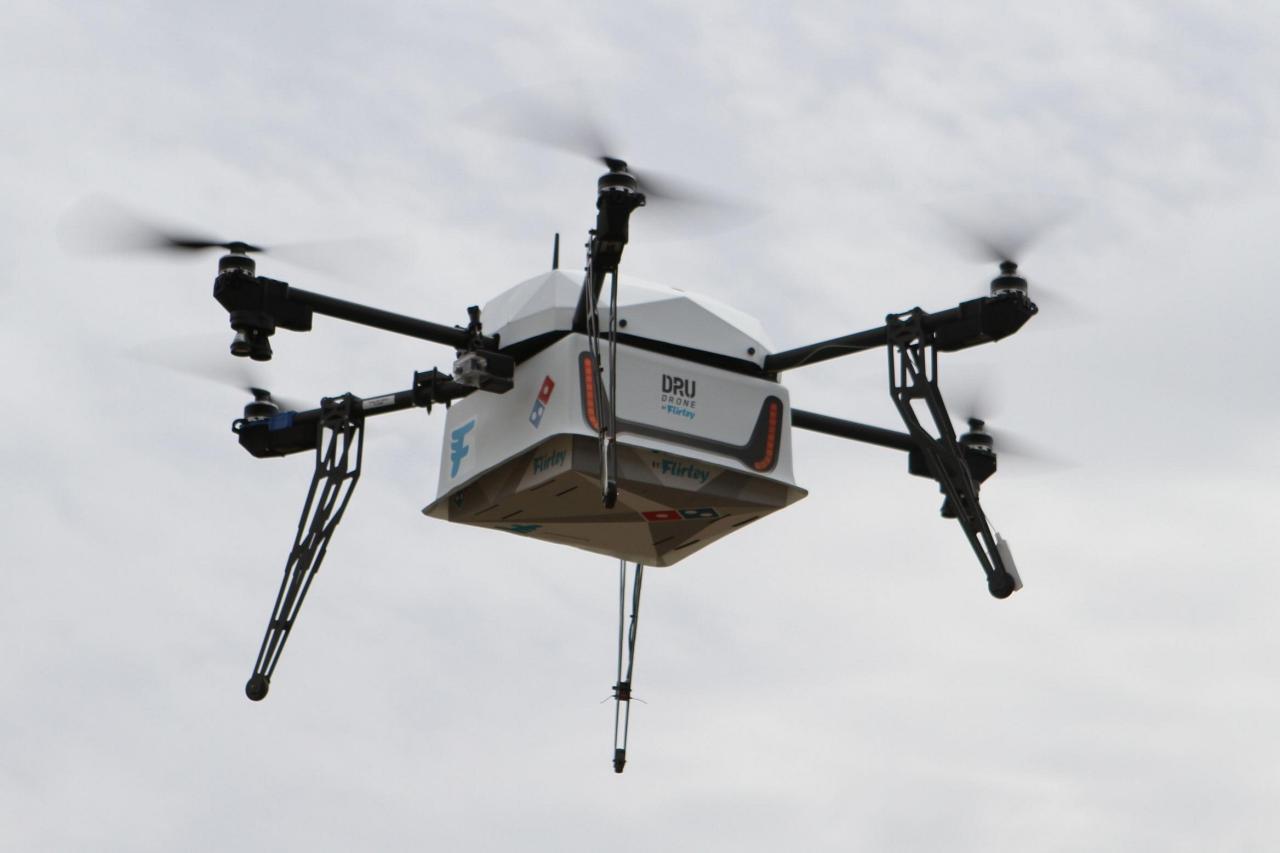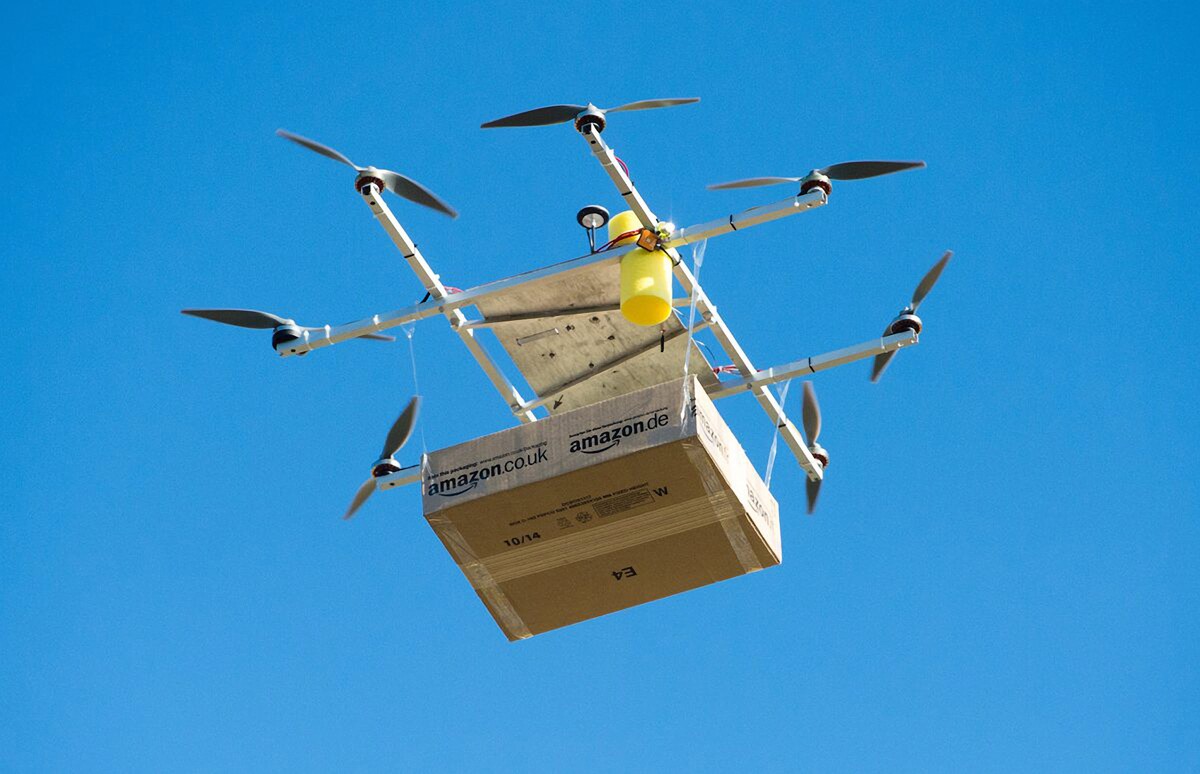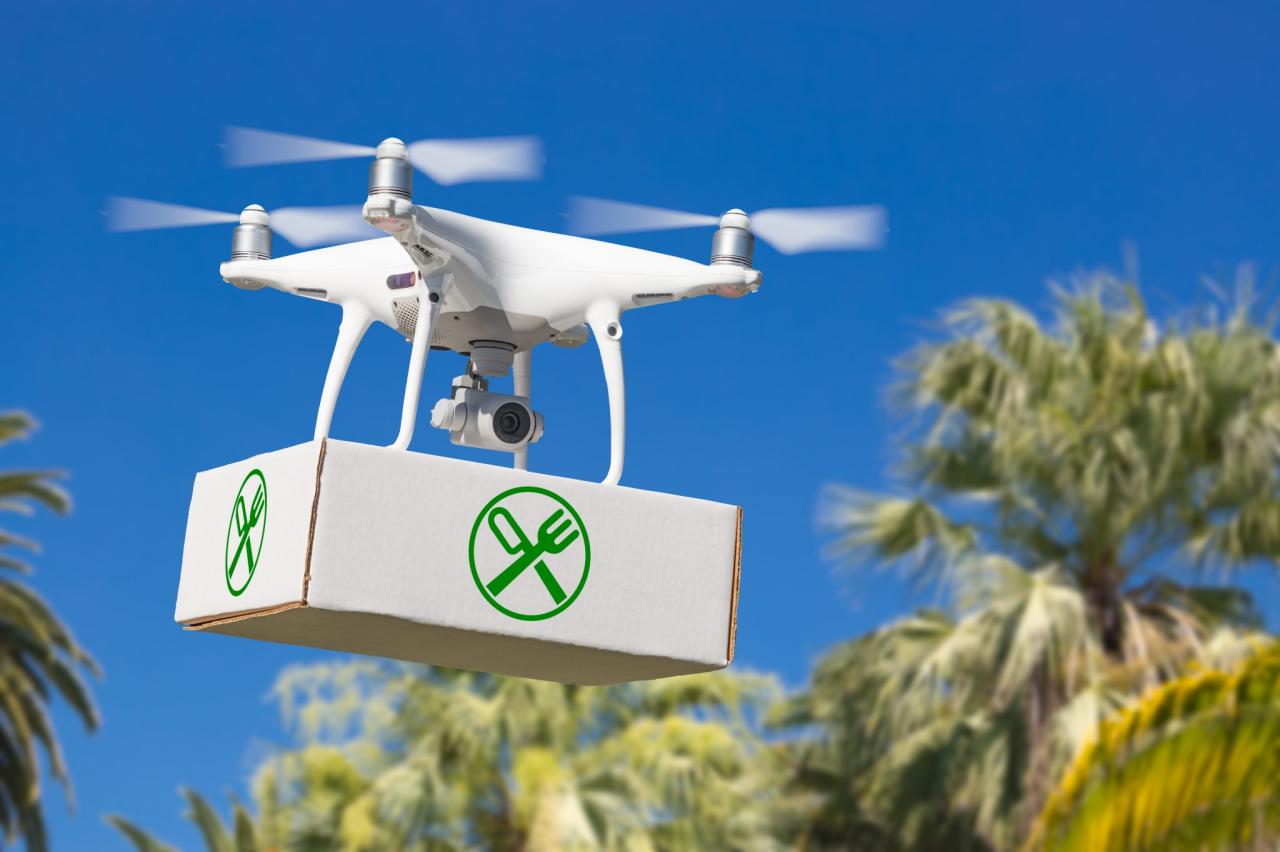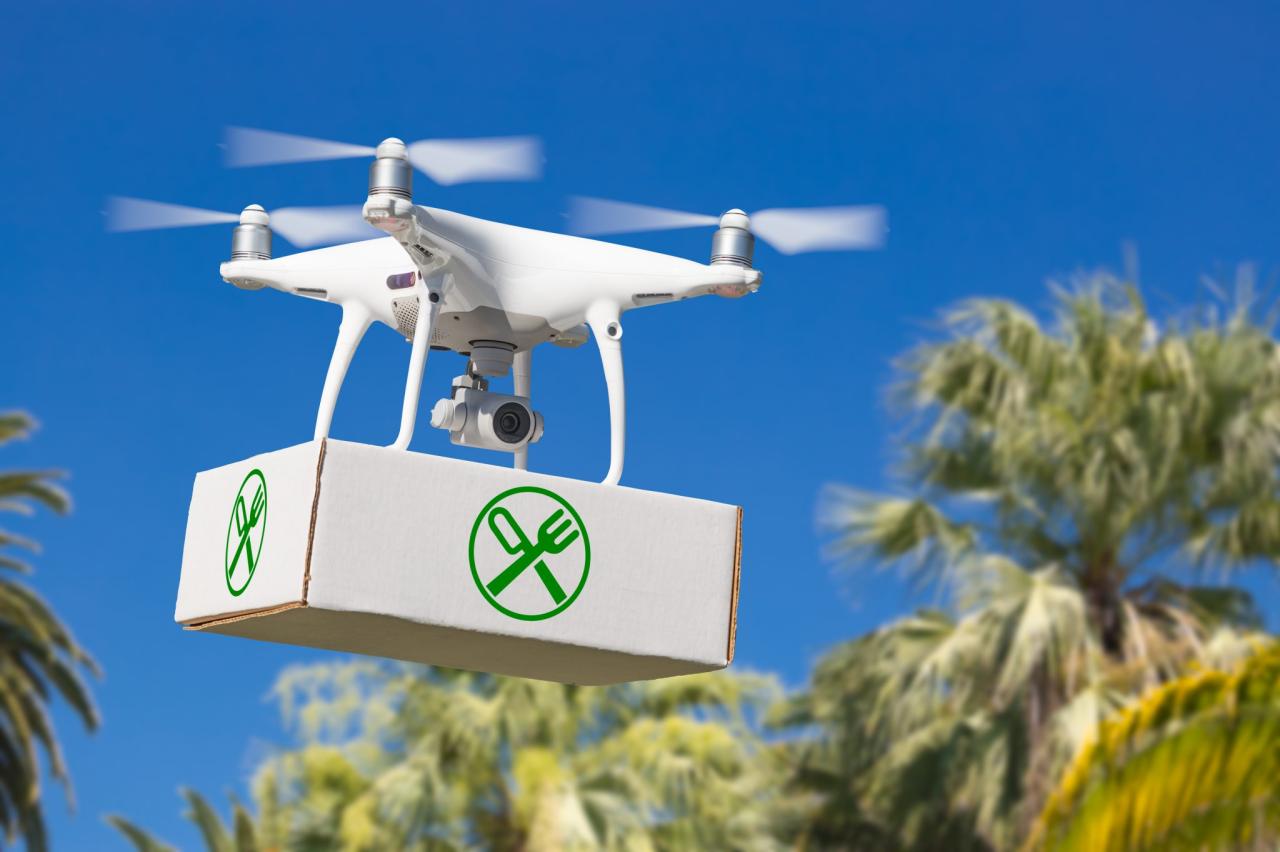Amazon drone delivery locations are rapidly expanding, revolutionizing how we receive packages. This exploration delves into the current operational status, location selection factors, technological underpinnings, customer experiences, and future potential of this innovative delivery system. We’ll uncover the key considerations behind where Amazon chooses to deploy its drones, the technology enabling these deliveries, and the impact on both customers and the broader landscape of logistics.
From the infrastructure requirements of drone hubs and charging stations to the intricate navigation systems and safety protocols, we’ll examine the multifaceted nature of Amazon’s drone delivery program. We’ll also analyze customer feedback, comparing the drone delivery experience to traditional methods, and explore the environmental implications of this emerging technology. Finally, we’ll look ahead to the future expansion plans and the potential transformative impact on various industries.
Current Amazon Drone Delivery Program Status: Amazon Drone Delivery Locations

Amazon’s drone delivery program, officially known as Amazon Prime Air, is steadily progressing, though it’s still far from widespread implementation. While initial ambitions were quite ambitious, the reality is a more measured rollout focused on refining technology and navigating regulatory hurdles. The program is currently operating in a limited capacity, focusing on specific geographic areas and delivery types.Amazon Prime Air’s operational status involves a phased approach.
The company has conducted numerous test flights and small-scale deliveries, gathering crucial data to improve drone performance and safety protocols. These tests have been instrumental in identifying and resolving various challenges, from weather conditions to airspace management.
Geographic Areas of Operation and Limitations
Currently, Amazon Prime Air’s operational area is restricted to a handful of locations primarily in the United States. Deliveries are limited to areas with relatively flat terrain and minimal obstacles, avoiding complex urban environments with dense buildings and unpredictable air traffic. Furthermore, weather conditions significantly impact operational capabilities; strong winds, rain, or snow can ground the drones. The program is subject to stringent FAA regulations, which further limit its scope and expansion rate.
Deliveries are typically limited to packages under a certain weight and size.
Examples of Successful Drone Deliveries
Amazon has successfully delivered various packages via drone, including everyday items like household goods, over-the-counter medications, and small electronics. While exact delivery times aren’t consistently publicized, reports suggest deliveries can be completed within 30 minutes or less, significantly faster than traditional ground delivery services for short distances. For example, in Lockeford, California, Amazon has successfully completed numerous deliveries of everyday items to customers within a designated service area.
Infrastructure Requirements for Amazon’s Drone Delivery Network
Amazon’s drone delivery network relies on a sophisticated infrastructure consisting of drone hubs and charging stations. These hubs serve as central locations for drone operations, housing drones, charging stations, and maintenance facilities. The drones themselves are equipped with advanced sensors and autonomous navigation systems, allowing for precise and safe deliveries. The charging stations are crucial for ensuring the drones can complete multiple deliveries throughout the day.
The location and number of these hubs and stations are strategically determined to optimize delivery routes and minimize delivery times. Furthermore, robust communication networks are necessary to maintain constant contact with the drones and monitor their status.
Comparison of Amazon’s Drone Delivery Program to Other Drone Delivery Services
Several companies are exploring drone delivery, although widespread commercial operation remains limited. A direct comparison is challenging due to the varied stages of development and limited public information. However, a general comparison can be made.
| Company | Geographic Coverage | Package Size Limits | Delivery Speed |
|---|---|---|---|
| Amazon Prime Air | Limited areas in the US | Varies by location and drone model; generally small to medium packages | Under 30 minutes (for short distances) |
| Other Companies (e.g., Wing, Zipline) | Varying locations globally, often rural or suburban areas | Varies depending on the company and drone model | Varies; generally faster than traditional ground delivery for short distances |
Factors Influencing Location Selection for Drone Delivery
Amazon’s drone delivery program, while ambitious, faces significant logistical hurdles. The selection of suitable locations is paramount to its success, demanding careful consideration of a multitude of factors, balancing operational efficiency with regulatory compliance and community needs. Successful deployment hinges on choosing areas where the benefits of faster delivery outweigh the challenges of infrastructure development and operational limitations.
So you’re curious about where Amazon’s delivering packages via drone? It’s pretty cool, right? To get a better idea of the current scope, check out this helpful resource on amazon drone delivery locations to see which areas are currently benefiting from this futuristic delivery method. Knowing these locations helps you understand the rollout and maybe even see if your area is next!
Population Density and Demand
Population density directly impacts the economic viability of drone delivery. High-density areas, like densely populated urban neighborhoods or suburban communities with high order volumes, offer a larger potential customer base, justifying the investment in infrastructure and operational resources. Conversely, sparsely populated rural areas may require extensive flight routes and potentially longer delivery times, reducing the cost-effectiveness. For example, a concentrated residential area with a high online shopping rate would be far more attractive than a widely dispersed rural community with low online purchasing.
Infrastructure and Accessibility
Existing infrastructure plays a crucial role. Areas with well-established digital infrastructure, including reliable internet connectivity for drone control and package tracking, are essential. The presence of suitable landing zones, such as designated areas on rooftops or in open spaces, is also critical. The absence of significant obstacles like tall buildings or dense tree cover is vital for safe and efficient drone navigation.
For instance, a suburban area with ample open space and readily available internet connectivity would be preferable to a dense urban center with numerous tall buildings and limited airspace.
Regulatory Environment and Airspace Restrictions
The regulatory environment significantly impacts location selection. Areas with supportive regulations and streamlined approval processes for drone operations are more attractive. Conversely, locations with restrictive airspace regulations or lengthy permitting procedures could hinder deployment. Amazon actively works with regulatory bodies to secure necessary approvals and to ensure its drone operations comply with all applicable laws and safety standards.
The ease of obtaining necessary permits and navigating airspace restrictions becomes a major factor in site selection.
Geographical Terrain and Weather Conditions
Geographical terrain and weather conditions pose significant operational challenges. Mountainous regions or areas with significant elevation changes can increase flight times and energy consumption. Adverse weather conditions, such as strong winds, heavy rain, or snow, can ground drones, disrupting operations. For example, a flat, coastal area with predictable weather patterns would be more suitable than a mountainous region with unpredictable weather and strong winds.
Coastal areas are less susceptible to extreme weather conditions compared to inland areas.
So you’re curious about where Amazon’s delivering packages via drone? It’s a pretty cool system, and the locations are expanding. To get the latest scoop on exactly which areas are currently seeing Amazon drone deliveries, check out this helpful resource: amazon drone delivery locations. Knowing these locations helps you understand the future of fast, efficient delivery and see if this tech is coming to your neighborhood soon!
Logistical Considerations for Infrastructure Establishment and Maintenance, Amazon drone delivery locations
Establishing and maintaining drone delivery infrastructure requires careful planning. This includes the selection and setup of drone charging stations, maintenance facilities, and secure storage for packages. The location of these facilities needs to consider proximity to delivery areas, accessibility for maintenance personnel, and security to prevent theft or damage. For example, a strategically located warehouse near a high-density residential area could serve as a central hub for drone operations, enabling efficient package distribution.
This location must also consider ease of access for both personnel and maintenance vehicles.
Urban vs. Suburban vs. Rural Locations
Urban areas offer high population density and demand but present challenges with airspace restrictions and infrastructure limitations. Suburban areas provide a balance of population density and infrastructure, making them attractive for initial deployment. Rural areas, while presenting lower demand, offer less congested airspace but may require extensive flight routes and higher operational costs. For example, a well-planned suburban community with readily available infrastructure and less restrictive airspace might be ideal for initial deployment, while a densely populated urban area like Manhattan might pose significant challenges due to airspace restrictions.
Conversely, a remote rural community might prove economically unfeasible due to the low population density and high operational costs.
Technological Aspects of Amazon Drone Delivery Locations

Amazon’s drone delivery program relies heavily on sophisticated technology to ensure safe and efficient operations. The success of the program hinges on the seamless integration of various technological components, from precise navigation systems to robust communication networks and comprehensive safety protocols. Let’s delve into the key technological aspects that make Amazon’s drone delivery possible.
GPS and Navigation Technologies
Accurate and reliable navigation is paramount for safe drone delivery. Amazon’s drones utilize GPS (Global Positioning System) technology, complemented by other navigation aids such as inertial measurement units (IMUs) and computer vision systems. GPS provides the drones with their location, allowing them to plan efficient routes and accurately pinpoint delivery locations. IMUs measure the drone’s orientation and movement, providing crucial data for stability and control, even in challenging conditions like strong winds.
Computer vision, using onboard cameras and advanced algorithms, allows the drone to identify and avoid obstacles, further enhancing safety and precision. This multi-layered approach ensures that drones can navigate complex environments and reach their destinations safely and accurately, even in areas with limited GPS signal strength.
Drone-Ground Control Communication Systems
Maintaining constant communication between the drones, ground control stations, and customers is critical for successful operations. Amazon employs a combination of technologies to achieve this. This includes dedicated radio frequency (RF) communication links for real-time data transmission between the drones and ground control. These systems allow ground controllers to monitor drone status, adjust flight paths as needed, and receive real-time telemetry data.
Furthermore, communication systems enable secure two-way data exchange, facilitating the management of flight parameters, and allowing for remote intervention in case of unexpected situations. For customer communication, the system incorporates features such as automated notifications and text message updates, keeping customers informed about the status of their deliveries.
Safety Features and Protocols
Safety is a top priority in Amazon’s drone delivery program. Several safety features and protocols are implemented to mitigate risks. These include redundant systems, such as backup batteries and navigation sensors, to ensure continued operation even in case of component failure. Automated obstacle avoidance systems, using sensor fusion technology, help drones navigate around obstacles in real-time. Furthermore, geofencing technology restricts drone operation to designated areas, preventing unauthorized flights.
Emergency procedures, including automated landing protocols and remote intervention capabilities, are in place to handle unexpected events. Regular maintenance and inspections of the drones and supporting infrastructure further contribute to ensuring safe operations.
Technological Advancements for Network Expansion
Expanding Amazon’s drone delivery network requires several key technological advancements.
- Improved Battery Technology: Longer flight times are essential for expanding delivery range and reaching more remote locations. This requires advancements in battery technology, focusing on increased energy density and reduced weight.
- Enhanced Obstacle Avoidance: More sophisticated obstacle avoidance systems, capable of handling complex and dynamic environments, are needed. This involves integrating advanced sensor technologies, such as LiDAR and improved computer vision algorithms.
- Advanced Air Traffic Management (ATM) Systems: Seamless integration with existing air traffic management systems is crucial for safe and efficient drone operations in increasingly congested airspace. This necessitates developing advanced drone traffic management systems and protocols.
- Resilient Communication Networks: Robust and reliable communication networks are essential for maintaining constant contact with drones, even in areas with limited cellular or satellite coverage. This involves exploring alternative communication technologies, such as mesh networks.
- Autonomous Package Handling: Automated package handling systems, allowing drones to autonomously load and unload packages, are needed for increased efficiency and scalability. This requires advancements in robotic grippers and autonomous manipulation technologies.
Customer Experience and Feedback on Drone Delivery
Amazon’s drone delivery program, while still in its relatively early stages, is generating a wealth of customer feedback, both positive and negative. This feedback is crucial for refining the service and improving the overall customer experience. Understanding these experiences helps shape the future of drone delivery.Customer feedback reveals a range of reactions, from enthusiastic acceptance to cautious skepticism.
Analyzing this feedback allows Amazon to address concerns and optimize the program for broader adoption. This section will explore various aspects of customer experiences and how Amazon manages them.
Customer Feedback Examples
Positive feedback often centers around the speed and convenience of drone delivery. Many customers appreciate the novelty and efficiency, describing the experience as “futuristic” and “amazing.” For example, some customers have reported receiving packages in under 30 minutes, a significant improvement over traditional delivery times. Conversely, negative feedback frequently highlights concerns about package security and the limited availability of the service.
Some customers have expressed anxieties about the safety of drones, particularly in densely populated areas. Others have noted that the program is only available in a limited number of locations, restricting its overall usefulness. Specific examples include reports of packages being slightly damaged during delivery or experiencing delays due to unforeseen weather conditions.
Drone Delivery Notification and Tracking
Customers are typically notified of an upcoming drone delivery via the Amazon app. This notification includes an estimated delivery time window, and a real-time tracking feature allows customers to monitor the drone’s progress. The app provides visual updates, showing the drone’s location on a map and its estimated time of arrival. This transparency helps to manage customer expectations and alleviate anxieties.
Customers can also receive alerts if there are any unexpected delays or issues with the delivery.
Comparison of Delivery Methods
The following table compares the customer experience of drone delivery with traditional delivery methods:
| Delivery Method | Speed | Cost | Customer Satisfaction |
|---|---|---|---|
| Drone Delivery | Very Fast (minutes to hours) | Potentially Higher (depending on location and package size) | Generally High for speed and novelty, but lower for availability and potential concerns |
| Traditional Delivery (Ground) | Slow (hours to days) | Generally Lower | Generally Moderate, varies depending on carrier and delivery time |
Addressing Customer Concerns and Resolving Issues
Amazon employs several strategies to address customer concerns and resolve issues related to drone deliveries. The company utilizes its customer service channels, including phone support and online chat, to handle complaints and inquiries. In cases of damaged packages or delivery failures, Amazon typically offers refunds or replacements. Proactive communication, such as timely notifications and updates, is also used to manage customer expectations and prevent potential problems.
Furthermore, Amazon actively collects and analyzes customer feedback to continuously improve its drone delivery service, addressing areas where customer satisfaction is lower. For instance, if a significant number of customers report issues with package damage, Amazon may investigate the cause and implement solutions such as improved drone packaging or revised delivery procedures.
Future Expansion and Potential of Amazon Drone Delivery Locations

Amazon’s drone delivery program, while still in its relatively early stages, shows immense promise for reshaping logistics and e-commerce. The company’s ambitious plans for expansion point towards a future where drone deliveries become a commonplace occurrence, impacting numerous sectors and altering how we receive goods.Amazon’s plans for future expansion involve a multi-pronged approach. This includes increasing the number of delivery locations within existing operational areas, expanding into new metropolitan areas both domestically and internationally, and potentially leveraging drone delivery for more specialized services like delivering medical supplies or urgent packages.
We can expect to see a gradual increase in the number of operational drones and a wider range of package sizes and types accommodated. The geographical expansion will likely prioritize areas with high population density, suitable infrastructure, and favorable regulatory environments. Expansion into rural areas might follow, but this will require overcoming challenges related to infrastructure and regulatory hurdles.
Amazon’s Drone Delivery Network Expansion Plans
Amazon’s expansion will focus on strategically selected locations. This will involve a careful analysis of factors like population density, existing infrastructure (including suitable launch and landing zones), regulatory approvals, and the overall cost-effectiveness of drone delivery in a given area. Areas with high e-commerce activity and a demand for faster delivery times will be prioritized. We can expect to see a phased rollout, starting with larger metropolitan areas and gradually extending to smaller cities and potentially even rural communities.
International expansion will likely follow a similar pattern, starting with countries with supportive regulatory frameworks and strong e-commerce markets. For example, we might see expansion into major cities in Europe and Asia in the coming years, following successful trials and regulatory approvals.
So you’re curious about where Amazon’s delivering packages via drone, huh? It’s pretty cool tech! To get a better idea of the current rollout, check out this handy list of amazon drone delivery locations to see if your area’s on the map. Knowing these locations helps you understand the expansion of this exciting delivery method.
Impact of Drone Delivery on Various Industries
The widespread adoption of drone delivery has the potential to significantly impact various industries. The retail sector will be one of the most profoundly affected, experiencing increased efficiency and reduced delivery costs. The healthcare industry could also benefit from faster delivery of medical supplies and pharmaceuticals, particularly in remote areas. The logistics industry itself will undergo a transformation, with drone delivery becoming an integral part of the supply chain.
This will create new job opportunities in drone maintenance, operation, and management. However, some industries, such as traditional delivery services, may face challenges adapting to this new technology.
Environmental Benefits and Drawbacks of Widespread Drone Delivery
Drone delivery offers potential environmental benefits, particularly in reducing carbon emissions associated with ground transportation. By using electric-powered drones, Amazon aims to minimize its environmental footprint. However, there are potential drawbacks. The manufacturing and disposal of drones contribute to environmental pollution. Increased drone traffic could also lead to noise pollution and potential hazards to wildlife and airspace safety.
Therefore, a comprehensive environmental impact assessment is crucial before widespread implementation. This would include considerations like battery technology, drone lifespan, and the management of drone waste.
Predicted Growth and Expansion of Amazon Drone Delivery (Infographic)
This infographic depicts the projected growth of Amazon’s drone delivery service over the next five years. Year | Number of Delivery Locations | Geographical Area Coverage | Package Volume
- —— | ——– | ——– | ——–
- | 100+ | Primarily major US cities | 1 million+ packages
- | 500+ | Expansion to additional US cities and select international locations | 5 million+ packages
- | 1000+ | Significant expansion across US and several international markets | 15 million+ packages
- | 2000+ | Widespread coverage in major US and international cities | 40 million+ packages
- | 5000+ | Extensive coverage across multiple countries | 100 million+ packages
This projection is based on current trends and Amazon’s stated ambitions. The actual figures may vary depending on factors like regulatory approvals, technological advancements, and market demand. For example, unexpected regulatory delays could slow down the expansion rate, while significant technological breakthroughs could accelerate it. Furthermore, consumer adoption and market competition will also influence the final numbers.
Final Summary
Amazon’s drone delivery program represents a significant leap forward in logistics, offering the potential for faster, more efficient, and potentially more environmentally friendly deliveries. While challenges remain, the ongoing development and expansion of this technology promise a future where receiving packages via drone is commonplace. Understanding the factors influencing location selection, the technological advancements driving progress, and the customer experience is key to appreciating the transformative potential of this revolutionary delivery method.
The future of package delivery is in the air, and Amazon is leading the charge.
General Inquiries
What types of packages can be delivered via Amazon drones?
Currently, Amazon drones deliver smaller packages, typically weighing under 5 pounds. The types of goods vary, but often include everyday items.
How much does drone delivery cost?
The cost is generally integrated into the standard Amazon Prime shipping fee; there isn’t a separate charge for drone delivery.
What happens if a drone malfunctions during delivery?
Amazon has safety protocols in place. In case of malfunction, the drone will attempt a safe landing, and customer service will be notified to arrange a redelivery via traditional methods.
Is drone delivery available everywhere?
No, it’s currently limited to specific locations due to regulatory approvals, infrastructure, and geographic suitability. Amazon is gradually expanding its drone delivery network.
What are the environmental benefits of drone delivery?
Potentially reduced carbon emissions compared to traditional delivery methods, particularly for shorter distances, as drones can be more fuel-efficient.
